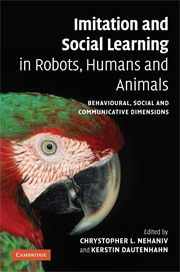 Imitation and Social Learning in Robots, Humans and Animals
Imitation and Social Learning in Robots, Humans and Animals Book contents
- Frontmatter
- Contents
- List of plates
- List of figures
- List of tables
- List of contributors
- Introduction: the constructive interdisciplinary viewpoint for understanding mechanisms and models of imitation and social learning
- Part I Correspondence problems and mechanisms
- Part II Mirroring and ‘mind-reading’
- Part III What to imitate?
- 7 The question of ‘what to imitate’: inferring goals and intentions from demonstrations
- 8 Learning of gestures by imitation in a humanoid robot
- 9 The dynamic emergence of categories through imitation
- Part IV Development and embodiment
- Part V Synchrony and turn-taking as communicative mechanisms
- Part VI Why imitate? – Motivations
- Part VII Social feedback
- Part VIII The ecological context
- Index
- Plate section
- References
7 - The question of ‘what to imitate’: inferring goals and intentions from demonstrations
Published online by Cambridge University Press: 10 December 2009
- Frontmatter
- Contents
- List of plates
- List of figures
- List of tables
- List of contributors
- Introduction: the constructive interdisciplinary viewpoint for understanding mechanisms and models of imitation and social learning
- Part I Correspondence problems and mechanisms
- Part II Mirroring and ‘mind-reading’
- Part III What to imitate?
- 7 The question of ‘what to imitate’: inferring goals and intentions from demonstrations
- 8 Learning of gestures by imitation in a humanoid robot
- 9 The dynamic emergence of categories through imitation
- Part IV Development and embodiment
- Part V Synchrony and turn-taking as communicative mechanisms
- Part VI Why imitate? – Motivations
- Part VII Social feedback
- Part VIII The ecological context
- Index
- Plate section
- References
Summary
Getting a robot to imitate is a difficult task. Currently, researchers are tackling difficult issues such as the ‘correspondence problem’ (Nehaniv and Dautenhahn, 2002) of how to map different aspects of a demonstration to one's own imitative response, how to decide whom, when and what to imitate, and how to evaluate success (Dautenhahn and Nehaniv, 2002a, b). From our perspective, the most interesting of these issues is the question of what to imitate, that is, which aspects of a demonstration robots should copy. This is because in many situations, instead of copying others' actions and their results on the environment exactly, it is often more useful to extract and adopt the goal of the demonstrator's actions, and only copy the actions and results of the demonstrator if they are intended and relevant or essential to the task.
To illustrate, imagine the following scenarios. A robot is presented with the following demonstration and then told to imitate.
(1) An actor approaches a lever and pushes it with his foot.
Here, copying the actor's action and its result might be appropriate: the robot should also push the lever with its foot (assuming it has one).
(2) An actor whose arms are broken pushes the lever with his foot.
Now it might be more appropriate for the robot to use a different action to achieve the same result: it could push the lever with its hands (assuming it has them), as the constraint of not having usable hands – the normal thing to use to push things – does not apply to it.
[…]
- Type
- Chapter
- Information
- Imitation and Social Learning in Robots, Humans and AnimalsBehavioural, Social and Communicative Dimensions, pp. 135 - 152Publisher: Cambridge University PressPrint publication year: 2007
References
- 8
- Cited by


